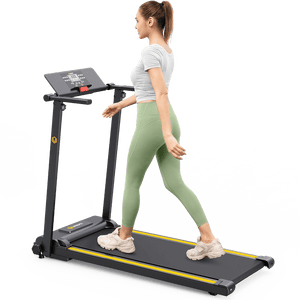Treadmills, frequently used fitness equipment in gyms and homes, offer a reliable way to engage in cardiovascular workouts without needing to head outdoors. One critical specification often overlooked when selecting a treadmill is its weight capacity, which ensures the treadmill operates safely and efficiently.
Treadmill Weight Capacity
Weight capacity is the maximum load a treadmill can safely handle while maintaining optimal performance. Weight capacity generally ranges from 200 to over 400 pounds, depending on the model and its target users. The treadmill's weight capacity is essential to know for multiple reasons:
- Exceeding the recommended limit can lead to wear and tear on the machine, affecting its performance and shortening its lifespan.
- Overburdening a treadmill also poses a safety risk to the user. If the treadmill is pushed beyond its designed limit, it could fail to provide stable support, leading to accidents or malfunctions.
- A treadmill operating near or above its weight limit might not deliver smooth or consistent performance, resulting in discomfort during exercise.
If selecting a treadmill, it is advisable to choose a model with a weight capacity that exceeds your weight by at least 20-30%. The buffer ensures that the treadmill operates efficiently without strain, even during high-impact exercises such as running or interval training.

Factors Influencing Treadmill Weight Capacity
There are many things in play that determine a treadmill's weight capacity
Treadmill Design and Materials
Sturdier frames crafted from high-quality steel or aluminum typically support higher weight limits. The deck and belt construction also play a role in determining weight capacity. Thicker decks and robust cushioning systems are designed to handle the stress of heavier users, providing greater durability and comfort. Cheap materials or poor construction, on the other hand, tend to limit the treadmill’s ability to bear heavier weights safely.
Motor Power and Performance
Motors are rated in horsepower (HP), and those with higher ratings can support heavier users. A more powerful motor can sustain continuous operation without overheating or losing efficiency, even when dealing with increased weight. Additionally, motor power influences how well the treadmill performs at higher speeds and inclines, further affecting the overall user experience. For individuals close to the treadmill’s weight limit, a more powerful motor ensures smoother operation and longevity.
Intended Use of the Treadmill
Commercial treadmills found in gyms often feature higher weight capacities because they are built to accommodate a variety of users and frequent usage. In contrast, home treadmills may have lower weight limits, particularly if designed for casual or infrequent use. Treadmills built for running tend to have higher weight capacities than those intended for walking or light jogging, as running exerts more force on the deck and motor.
How to Choose a Treadmill Based on Weight Capacity
Assess Your Needs
For runners or heavier users, choose a treadmill with a weight capacity of at least 300-350 pounds (136-159 kg) to handle greater impact forces and ensure durability. If multiple users of varying weights will use it, opt for a higher capacity of around 350-400 pounds (159-181 kg).
For lighter users or those focused on walking or light jogging, a treadmill with a capacity of 250-300 pounds (113-136 kg) is usually sufficient. Consider future needs, such as adding accessories or increasing workout intensity, and aim for a treadmill with a buffer of 20-30% above your current weight.
Test the Treadmill
Test the treadmill by walking or running to check stability and comfort. Heavier-duty treadmills with a 3.0-4.0 HP motor will run smoothly under heavier loads, while those designed for lighter exercise may have lower HP but still perform well for walking. Ensure it feels sturdy, with good shock absorption and minimal noise. If the treadmill struggles or vibrates excessively near its weight limit, it may not be the best fit.

Common Myths About Treadmill Weight Capacity
"Higher Capacity Equals Better Quality"
While higher capacity treadmills often have more robust construction, this does not necessarily mean they are superior in every aspect. The quality of a treadmill depends on various things such as motor performance, durability of materials, and features like incline settings or workout programs. A treadmill with a moderate weight capacity might still offer excellent performance and durability for users within its recommended limits.
"Weight Capacity is Just a Number"
The weight capacity is a carefully calculated specification, and exceeding it can lead to severe consequences. Overloading a treadmill can result in premature wear, motor strain, and even potential safety hazards. And warranties often become void if the treadmill is used beyond its specified limits.
FAQs
Is a treadmill good for an overweight person?
Yes, treadmills are suitable for overweight individuals. They provide low-impact exercise and many models offer cushioning for joint support. Just choose a treadmill with an appropriate weight capacity and start with walking, gradually increasing intensity.
What happens if you exceed the weight limit of a treadmill?
Exceeding the weight limit can cause the motor to overheat, the belt to wear out faster, and the deck to become unstable, increasing the risk of injury. It may also void the warranty and shorten the treadmill’s lifespan.
Can a treadmill help improve my running form?
Yes, a treadmill can be a great tool to improve running form. With a controlled environment, you can focus on posture, stride length, and foot placement. Some treadmills even offer features like incline and speed variation, allowing you to practice different running techniques.
What’s the difference between a manual treadmill and an electric treadmill?
A manual treadmill is powered solely by your movement, meaning you have to push the belt with your feet. It’s typically harder to get started and maintain speed. Electric treadmills, on the other hand, have a motor that moves the belt, and you adjust the speed through a control panel. Electric treadmills offer more features and are better suited for a wide range of workouts, but manual ones can provide a more intense cardio workout due to the added effort.
How can I make treadmill workouts more engaging?
Treadmill workouts can feel repetitive, but you can make them more engaging by incorporating intervals, adjusting incline, or following treadmill-specific workout programs. Listening to music, watching videos, or even using a virtual running app can also help keep things interesting. Set challenges for yourself, like increasing your speed or covering more distance each week, to stay motivated.
Can I lose weight using a treadmill if I only walk?
Yes, walking on a treadmill can contribute to weight loss, especially if combined with a healthy diet and consistency. Walking at an incline or incorporating interval walking (alternating between fast and slow paces) can increase calorie burn. Regular walking helps build endurance, improves cardiovascular health, and burns calories over time.
How often should I maintain or service my treadmill?
Basic maintenance includes cleaning the belt and deck after each use to remove dust and dirt, lubricating the belt every three to six months (depending on usage), and checking the motor and electrical components annually. If the treadmill starts making unusual noises or showing signs of wear, it may be time to have it professionally serviced.
Can I train for a marathon using a treadmill?
Yes, treadmills can be useful tools for marathon training, especially when outdoor conditions aren’t ideal. You can simulate outdoor running conditions by adjusting the incline, varying speed, and following a marathon training plan specifically designed for treadmills. Just make sure to mix in some outdoor runs, as the variation in terrain and conditions helps better prepare your body for the actual race.
What is the typical lifespan of a treadmill?
On average, a well-maintained treadmill used regularly can last between 7 to 12 years. High-quality commercial treadmills can last longer, around 15 years, while less expensive models may only last 5 to 7 years with heavy use.
How much weight can a typical home treadmill support?
The average home treadmill typically supports between 250 to 300 pounds (113 to 136 kg). Some higher-end models can support up to 400 pounds (181 kg). For commercial treadmills, the weight capacity is often higher, generally around 350 to 450 pounds (159 to 204 kg). Always check the specific weight limit of the treadmill before purchasing.
What is the average treadmill belt size, and how does it affect usage?
The standard belt size for a treadmill is around 20 inches wide and 55-60 inches long. For walking or light jogging, a 50-55 inch long belt may be sufficient. However, for taller users or runners, a belt length of 60 inches or more is recommended to provide adequate stride space. Wider belts, typically 22 inches or more, offer more comfort, especially for larger users.
How many calories can I burn running at 6 mph on a treadmill for 30 minutes?
On average, a person weighing 155 pounds (70 kg) can burn around 300-350 calories running at 6 mph (9.7 km/h) for 30 minutes. A heavier person may burn more calories, while someone lighter will burn fewer.
How many steps can you take on a treadmill in 30 minutes?
On average, walking at 3-4 mph for 30 minutes on a treadmill results in around 3,000 to 4,500 steps, depending on your stride length. Running at 6 mph for the same amount of time could result in approximately 5,000 to 6,000 steps. The exact number depends on individual stride length and speed.








































